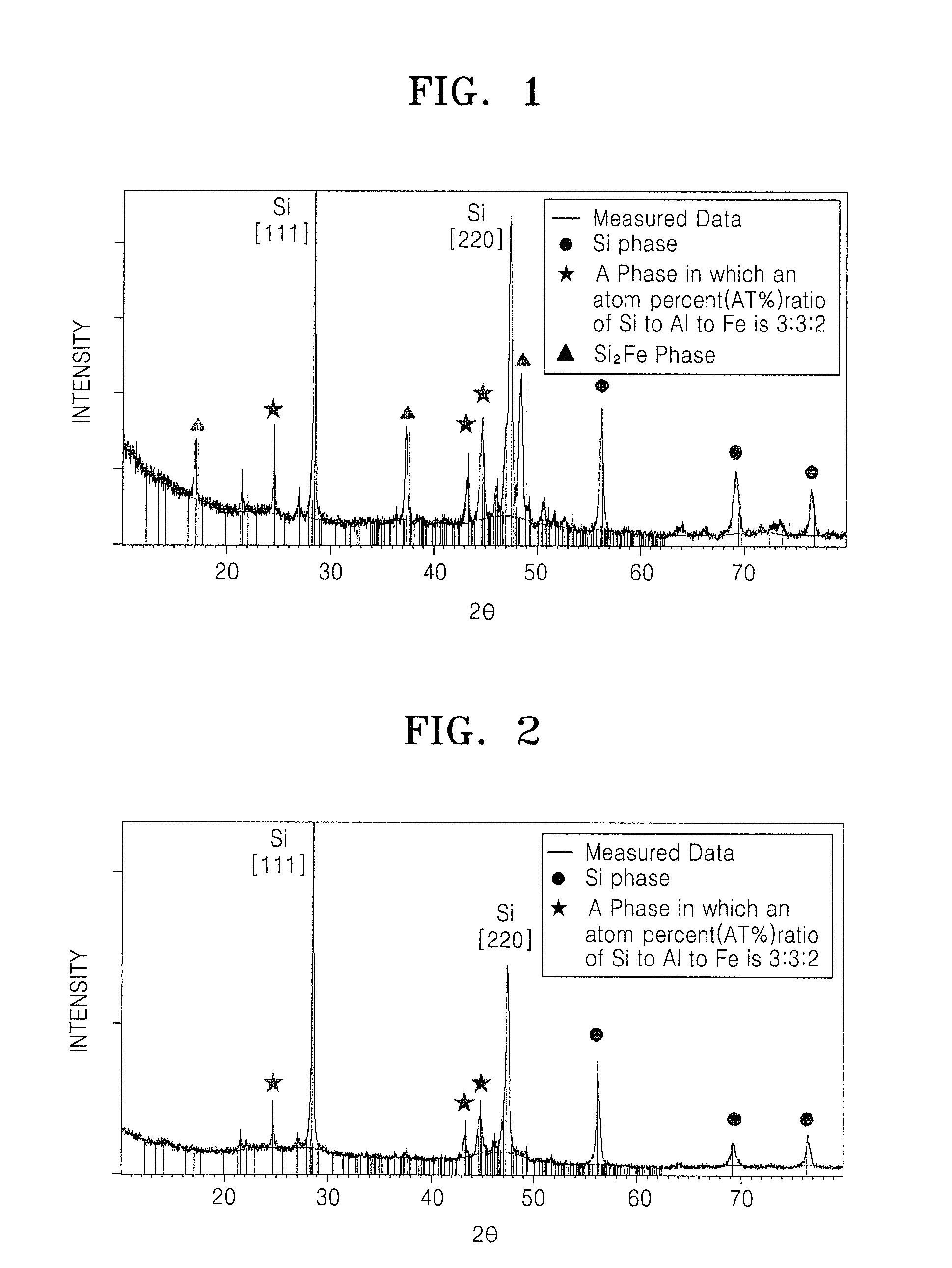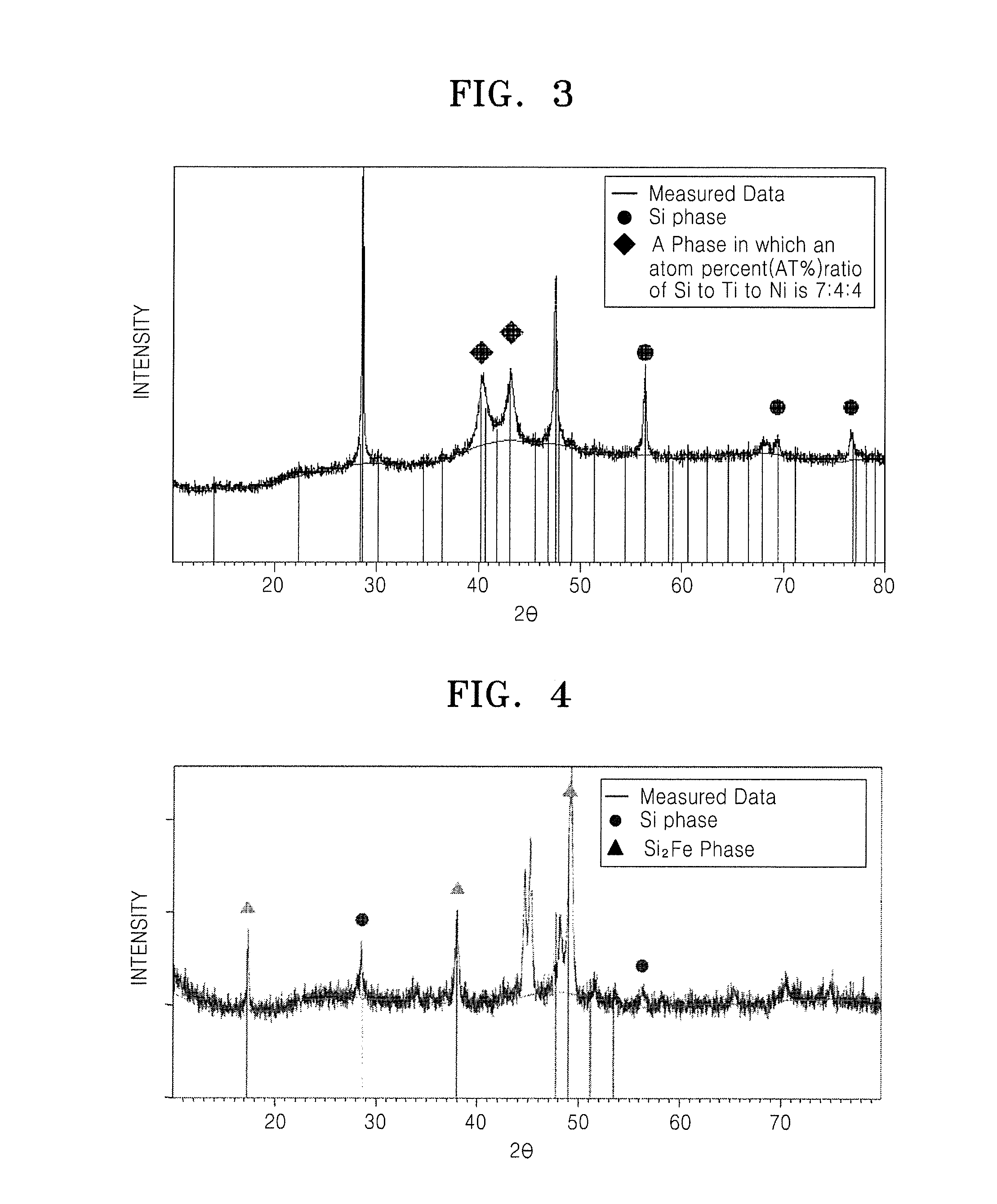Negative active material, method of preparing the same, negative electrode for lithium secondary battery including negative active material, and lithium secondary battery including negative electrode
a negative active material and negative active material technology, applied in the direction of electrode manufacturing process, non-conductive material with dispersed conductive material, electrode manufacturing process, etc., can solve the problems of low initial discharge capacity and cycle characteristics of negative electrode including such non-carbonaceous material, and reduce the cycle life of negative electrodes. , the cost of raw materials for si—ti—ni alloys is high, and the structure of negative electrodes is unstable.
- Summary
- Abstract
- Description
- Claims
- Application Information
AI Technical Summary
Benefits of technology
Problems solved by technology
Method used
Image
Examples
example 1
Negative active Material with a Composition of 68 at % Si-16 at % Al-16 at % Fe alloy
[0114]Si, Al, and Fe were mixed at a ratio of atomic percentages of 68:16:16. The mixture was melted in vacuum by using an induction melting furnace to prepare a parent alloy of Si, Al, and Fe. The prepared parent alloy was pulverized into an appropriate size, and the pulverized parent alloy was put in a graphite crucible, installed in a melt spinner, and then mixed at a temperature of 1400 to 1500° C. for 5 minutes while being melted. The melt-mixed parent alloy was quenched to room temperature at a quenching rate of 107 K / sec to prepare an alloy ribbon. The alloy ribbon was pulverized to prepare a negative active material formed of alloy powder having a median particle size distribution (D50) of 3.2 μm.
[0115]In the negative active material, a matrix phase alloy having 16 at % Si-16 at % Al-10.67 at % Fe was formed, thereby having a ratio of atomic percentages of Si to Al to Fe of 3:3:2. The remain...
example 2
Negative Active Material with a Composition of 65 at % Si-21 at % Al-14 at % Fe alloy
[0117]A negative active material was prepared in the same manner as in Example 1, except that Si, Al, and Fe were mixed at a ratio of atomic percentages of 65:21:14 instead of a ratio of atomic percentages of 68:16:16.
[0118]In the negative active material, a matrix phase alloy was formed to have a composition 21 at % Si-21 at % Al-14 at % Fe, thereby having a ratio of atomic percentages of Si to Al to Fe of 3:3:2. Substantially no FeSi2 phase was formed.
[0119]The remaining atomic percentage of Si (obtained by subtracting the 21 at % Si present in the matrix phase from the 65 at % of Si in the negative active material) was 44 at %. Thus, an active 44 at % Si phase was formed. Si at % of matrix phase alloy having a ratio of atomic percentages of Si to Al to Fe of 3:3:2 was 21 at % from the composition 21 at % Si-21 at % Al-14 at % Fe.
[0120]Therefore, in the negative active material, the ratio of Si at...
example 3
[0124]The negative active material prepared according to Example 1, polyamide imide, and Ketjen black were mixed at a weight ratio of 90:8:2 in N-methylpyrrolidone to prepare a negative active material slurry. The negative active material slurry was coated on a Cu current collector having a thickness of 10 μm using a doctor blade. The coated Cu current collector was dried in vacuum at 350° C. for 1 hour, thereby forming a negative active material layer having a thickness of 42 μm stacked on the Cu current collector. A hole having a diameter of 16 mm was made therethrough, thereby completing the manufacture of a negative electrode.
[0125]The negative electrode, a lithium electrode as a counter electrode, a microporous polypropylene separator (Celgard 3501), and an electrolytic solution including ethylene carbonate (EC), diethyl carbonate (DEC), and fluoroethylene carbonate (FEC) (the volume ratio of EC: DEC: FEC was 5:75:25) were assembled in a helium-filled glove box to manufacture a...
PUM
| Property | Measurement | Unit |
|---|---|---|
| Bragg angle 2θ | aaaaa | aaaaa |
| Bragg angle 2θ | aaaaa | aaaaa |
| particle size | aaaaa | aaaaa |
Abstract
Description
Claims
Application Information
 Login to View More
Login to View More - R&D
- Intellectual Property
- Life Sciences
- Materials
- Tech Scout
- Unparalleled Data Quality
- Higher Quality Content
- 60% Fewer Hallucinations
Browse by: Latest US Patents, China's latest patents, Technical Efficacy Thesaurus, Application Domain, Technology Topic, Popular Technical Reports.
© 2025 PatSnap. All rights reserved.Legal|Privacy policy|Modern Slavery Act Transparency Statement|Sitemap|About US| Contact US: help@patsnap.com



